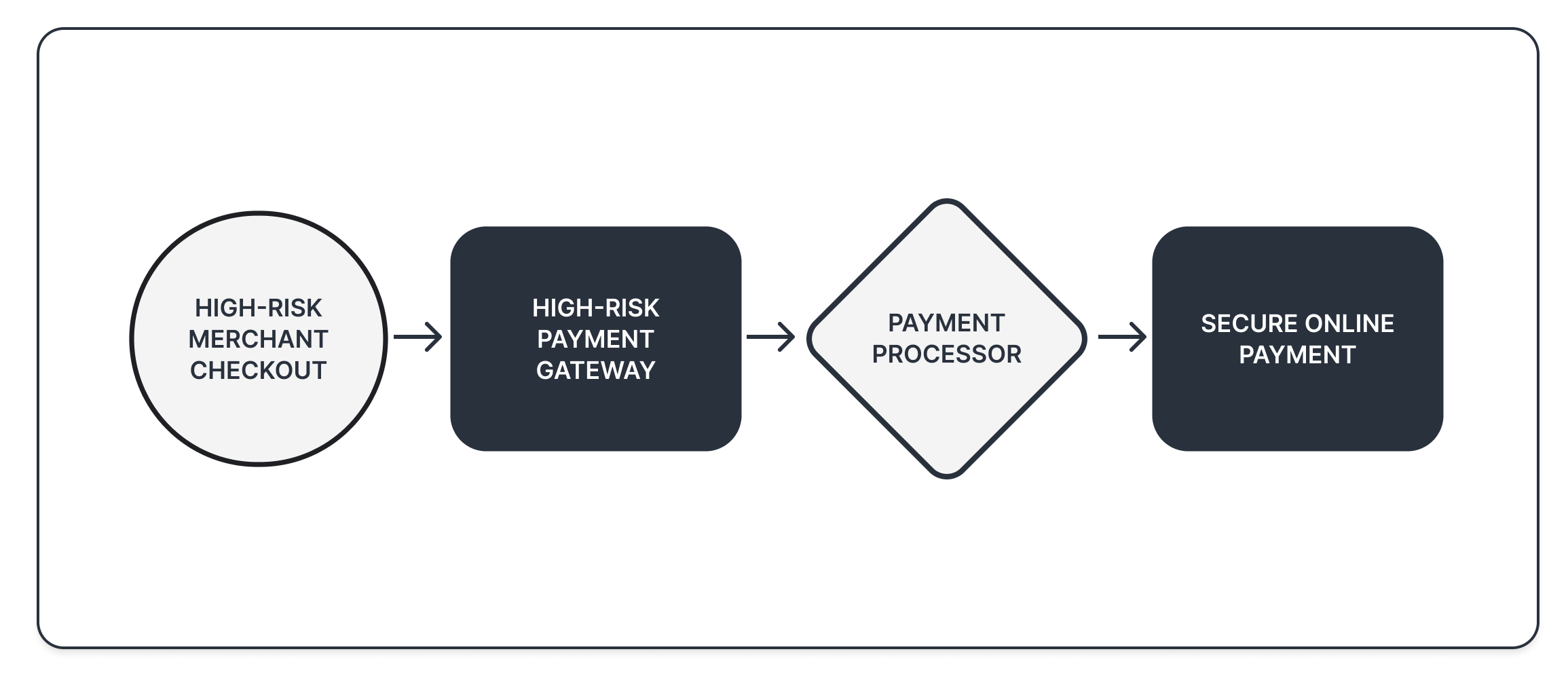The majority of businesses need a payment gateway to process successful payments, whether that is in person, online, by phone, by mail, etc. If you own a high-risk business, this may be difficult, however, as traditional payment gateways may deny your company due to the risks it poses.
Specialized high-risk payment gateways are made to handle the risks posed by high-risk businesses and provide customizable solutions for these business types.
What is a high-risk payment gateway?
A high-risk payment gateway is a middleman between a high-risk merchant and a payment processor. It is software that transfers credit card data and purchase information from the merchant checkout to the payment processor to enable secure online payments.

What business types are considered high-risk?
Any business has risks, and online businesses are no exception. Banks and card processors act as payment providers to merchants and assess the risks associated with payment processing for that specific business. They evaluate various factors, including credit card processing history, fraud rates, chargebacks, and more.
Each provider decides what factors are taken into account when determining which businesses are high-risk. Companies that typically fall under the high-risk category include:
- • Airline and event tickets
- • Dating
- • Adult Industry
- • Auctions, credit collection, crypto, pawn shops
- • Attorneys and brokers
- • Gambling, betting, gaming
- • Smoking-related or CBD products
- • Health and wellness products
- • Membership or subscription-based services
- • Companies assisting in offshore business activities
- • Real estate, furniture retailers, etc.
How to find a high-risk payment gateway
To accept online payments as a high-risk business, you need a high-risk merchant account. The average high-risk merchant account approval time will take at least a few days. Once you have a merchant account, getting a high-risk payment gateway is simple. Payment gateways simply encrypt card data to transfer it to the processor, so they aren’t taking on any of the merchant risks.

What to do when you need a high-risk merchant account
Due to the fact that you need a high-risk merchant account to get a high-risk payment gateway, you will need to know what to do to increase your odds of approval, including:
- Honesty: Be honest during the application. Only disclosing as little information as possible can hurt your approval odds.
- Cash Levels: Having cash on hand can signify stability. Banks prefer to see 25% to 50% of monthly card transaction volume in your account.
- Compile Documents: Be prepared with at least three to six months of bank statements to show where money is coming from and where that money is going.
- Assess Variables In Your Control: Asses the variables in your control, such as taking steps to improve your credit score or reducing your risk of chargebacks.
- Communicate Clearly: Not all chargebacks are avoidable. Some happen due to unhappy customers. You can reduce these kinds of chargebacks by communicating clearly with the customer. Is your return policy or shipping policy easy to understand? Can customers easily reach you to resolve issues?
Our team will guide you through the application process, help you gather the necessary documents, and increase your chances of approval.
Benefits of using a high-risk payment gateway
There are several benefits of using a high-risk payment gateway, including:
Safety
High-risk payment gateways have fraud and risk settings to authenticate cardholders and mitigate chargebacks. Advanced fraud tools offered can include browser fingerprinting, historical card database checks, email matching, IP blocking, and more.
Accessibility
The platform allows users to pay for online, in-store, or self-service payment options. The gateway also supports EMV technology and contactless payment systems.
International Payment Options
High-risk payment gateways are a simple way to make international purchases fast. These gateways allow international customers to access products without the hassle and with less involvement.
Account Termination
High chargebacks or an increase in the volume of transactions won’t put your business at risk for termination like with a standard merchant account. High-risk payment gateways are designed to handle high volumes of transactions and higher chargeback thresholds.
Scaling Up Your Business
High risk payment gateways are a great option if you want to expand your business. A high-risk payment gateway can help you generate more sales, add leads in more places and several currencies, and more.
Boost Revenue
A high-risk payment gateway gives businesses the opportunity to process recurring payments. High-risk payment processors make it easy for companies to retain customers. Recurring payments enable businesses to receive a steady stream of income to grow their business.
Technology Use
High-risk payment processors always offer the latest software to streamline your business and increase efficiency. Technology is constantly evolving and working with a high-risk payment gateway that understands these trends can help to expand your business.
High-risk payment gateways can also help you integrate your website with eCommerce platforms such as Shopify to allow your business to grow quickly as more customers visit your website.
| Pros of high-risk merchant accounts | Cons of high-risk merchant accounts |
|---|---|
| Access to broader markets | Higher fees |
| Higher chargeback tolerance | Stricter terms and conditions |
| Flexible payment options | Potential for limited processor options |
| Advanced fraud protection | Higher risk of account termination |
The top payment challenges of high-risk businesses
High-risk merchants face many payment challenges, including:
1. Obtaining Merchant Accounts
If banks consider your business to be high-risk, getting a merchant account can be more difficult. You will need to provide the proper documentation, and you may pay higher fees than a low-risk account.
2. High Processing Fees
High-risk payment gateways charge more to process transactions. Most companies charge 3 to 4 percent, however, the types of fees applied can vary.
3. Rolling Reserve
As a high-risk business, you will have to maintain a rolling reserve. Rolling reserve is when a particular share of your transaction volume gets put on hold for a time period and is released and settled after. This allows banks to protect themselves from anything that can go wrong within a risky business.
4. Chargebacks
High-risk businesses have a higher chargeback rate than others. High-risk payment gateways might set monthly thresholds.
5. Fraud
Online businesses, including high-risk businesses, are targets for fraud. There are lots of fraud schemes that are constantly evolving in the industry. Advanced anti-fraud tools are a must for any high-risk business.

Choosing a good high-risk payment gateway
To begin accepting payments from customers, you need a high-risk payment gateway. Here are a few essential factors to look for in a quality, high-risk payment gateway.
1. Security
Fraud schemes require the most up-to-date security options to protect your business and clients. Fraud monitoring, encryption, PCI DSS level 1 compliance, and tokenization are all essential security tools for a high-risk payment gateway to have.
2. Analytics And Management Tools
Monitoring payment flow, tracking conversions, and managing payouts are beneficial tools for high-risk merchants. Choose a high-risk payment gateway that offers value-added services such as analytics and dashboards.
3. Reasonable Fees
Choose a high-risk payment gateway with reasonable fees. Specific gateways take advantage of the situation of high-risk businesses because they know it’s challenging to obtain a high-risk merchant account and find a high-risk payment gateway, so they markup their services.
4. Coverage
The best high-risk payment gateways should support multiple payment methods and currency types to allow a merchant to do business worldwide. Ensure that the high-risk payment gateway you choose not only meets your current payment option needs but also will allow you to grow in the future.
5. Funds Deposit
You will want to choose a high-risk payment gateway that will allow you to collect your funds quickly after each transaction. The ideal high-risk payment gateway should be able to help you get your funds within 24 to 48 hours after you send a payment batch.
6. Customer Service
The high-risk payment gateway that you choose should be available 24 hours a day if possible and should be reachable by phone or live chat to answer questions whenever issues arise.
7. Integration
Choosing a high-risk payment gateway that integrates with your business is crucial. It should integrate with your accounting platforms, your website, and whatever software your company currently uses. The gateway should also be able to integrate with any mobile payment system, such as Google Pay and other mobile payment solutions.
Final thoughts
High-risk payment gateways are essential for a high-risk business to accept payments by credit card and debit card, whether online, by phone, in person, or by mail. High-risk payment gateways also offer many other benefits to businesses.
Partnering with a high-risk payment gateway can increase the security of transactions, mitigation of chargebacks, the ability to make international purchases simple, the ability to boost revenue, and the convenience of up-to-date technology.
Bankful’s payment gateway can offer you seamless integration with large eCommerce sites, virtual terminals, a seamless user experience, electronic invoicing, and more payment options, including ACH, eCheck Plus, check imaging, credit cards, and even cryptocurrency.
Try Bankful’s payment gateway today and streamline your business and user experience.

